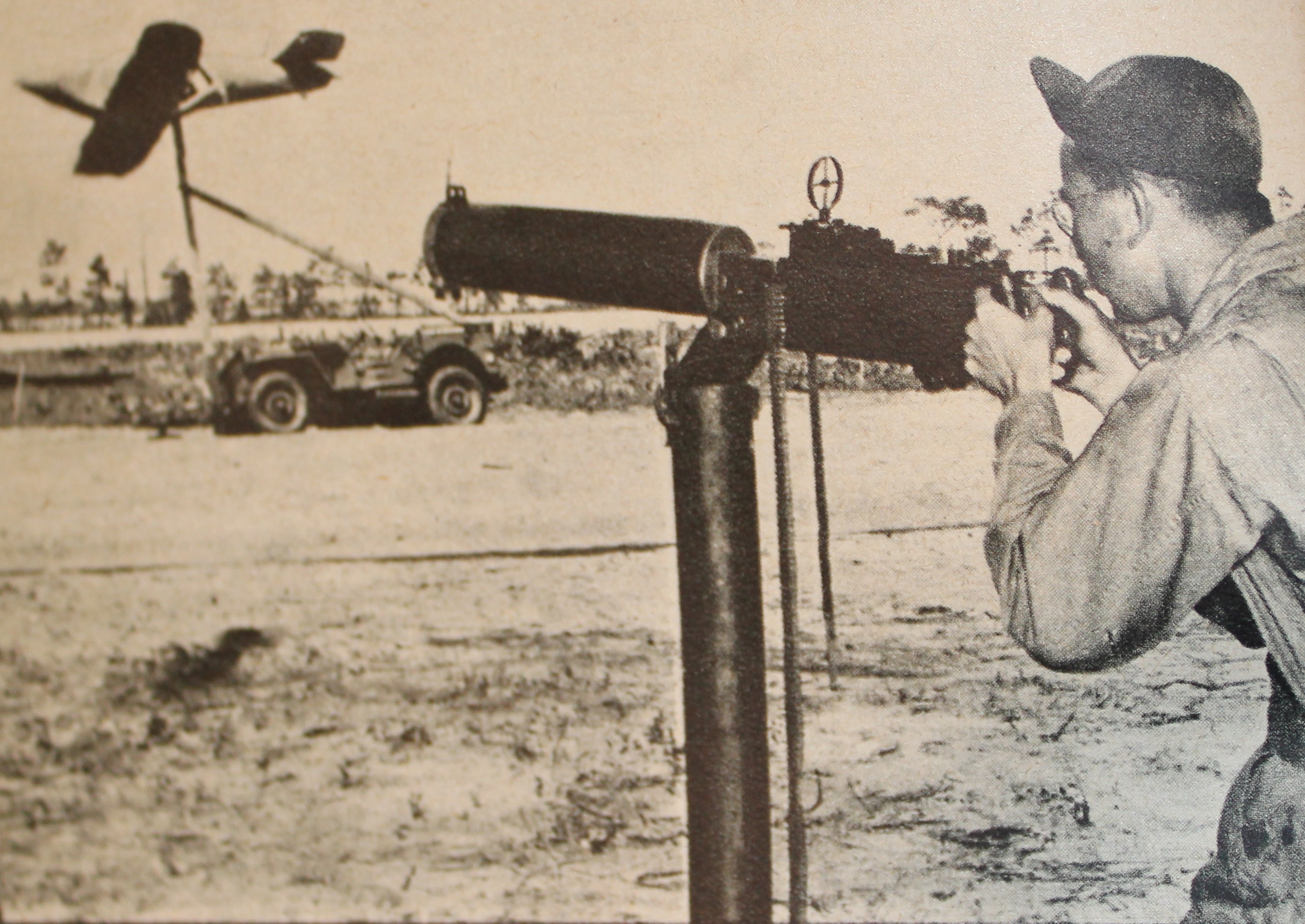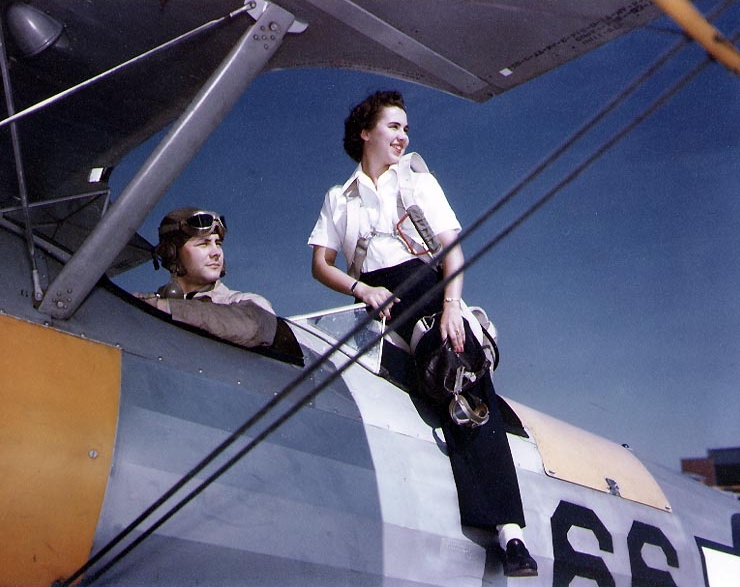|
Flexible Gunnery
Army Air Forces Gunnery Schools were World War II organizations for training personnel in the skill of aerial gunnery. The several schools existed at domestic Army Airfields and gunnery ranges (3 schools opened in 1941). "Flexible Gunnery" training developed diverse skills for various aircraft and differing positions within bombers, e.g., waist gunner, rear gunner, etc. (fixed gunnery training was used for tbd.) "The number of graduates had reached 19,789 by 7 July 1943, with another 57,176 men completing the course by the end of the year." For example, at Las Vegas Army Airfield 600 gunnery students and 215 co-pilots were graduated every five weeks at the height of World War II. Training started on the ground using mounted shotguns with fixed arcs of fire, and then shotguns mounted on the backs of trucks, which were driven through a course. Then the students went up in the bombers, shooting at targets pulled by other aircraft. Installations and media The USAAF had a "Cent ... [...More Info...] [...Related Items...] OR: [Wikipedia] [Google] [Baidu] |
1944 USAAF Gunnery Training
Events Below, the events of World War II have the "WWII" prefix. January * January 2 – WWII: ** Free France, Free French General Jean de Lattre de Tassigny is appointed to command First Army (France), French Army B, part of the Sixth United States Army Group in North Africa. ** Landing at Saidor: 13,000 US and Australian troops land on Papua New Guinea, in an attempt to cut off a Japanese retreat. * January 8 – WWII: Philippine Commonwealth troops enter the province of Ilocos Sur in northern Luzon and attack Japanese forces. * January 11 ** President of the United States Franklin D. Roosevelt proposes a Second Bill of Rights for social and economic security, in his State of the Union address. ** The Nazi German administration expands Kraków-Płaszów concentration camp into the larger standalone ''Konzentrationslager Plaszow bei Krakau'' in occupied Poland. * January 12 – WWII: Winston Churchill and Charles de Gaulle begin a 2-day conference in Marrakech ... [...More Info...] [...Related Items...] OR: [Wikipedia] [Google] [Baidu] |
Lowry Bombing And Gunnery Range
The Lowry Bombing and Gunnery Range (LBGR) was a World War II and Cold War facility that included 4 of the 6 HGM-25A Titan I missile launch complexes southeast of Denver, Colorado. Army Air Force range The area of the Lowry range was initially part of the 1937 Buckley Field's that became an Army Airfield in 1942. In World War II, bombing with " practice and HE bombs", training in "fixed and flexible gunnery", and rifle training were conducted at the range. The 1st of the Army Air Forces Bombardier Schools was at Lowry from July 1940 through March 14, 1941, used the Buckley range and graduated 3 instructor classes of graduates who opened the bombardier school at Barksdale Field. (from Volume Icited by ancestry.com) ;Camp Bizerte: Camp Bizerte at the range was a World War II training facility for simulating an overseas Army field camp. Part of the 12-week AAF Photography Course at Lowry Field in 1943 was conducted at Camp Bizerte. Lowry Bombing and Gunnery Range was designated af ... [...More Info...] [...Related Items...] OR: [Wikipedia] [Google] [Baidu] |
Harlingen Field
Harlingen Field (also known as Harlingen Municipal Stadium, Lon Hill Ballpark, or Giants Field) is a baseball park in Harlingen, Texas Harlingen ( ) is a city in Cameron County in the central region of the Rio Grande Valley of the southern part of the U.S. state of Texas, about from the coast of the Gulf of Mexico. The city covers more than and is the second-largest city in ..., that has been home to professional baseball, such as the Rio Grande Valley WhiteWings and the Harlingen Giants, and high school baseball. It has undergone numerous expansions and renovations throughout its fifty-year history, most notably in the early 2000s.http://mysite.verizon.net/charliesballparks/stadiums/harling.htm Sources * "Ghost Leagues: Minor League Baseball in South Texas," Noe Torres, c.2005 References Minor league baseball venues Harlingen, Texas Baseball venues in Texas Buildings and structures in Cameron County, Texas Florida Complex League ballparks High school baseball ... [...More Info...] [...Related Items...] OR: [Wikipedia] [Google] [Baidu] |
Buckingham Field
Buckingham Field is a private-use airport located seven nautical miles (13 km) east of the central business district of Fort Myers, in Lee County, Florida, United States. It is privately owned by the Lee County Mosquito Control District. The Buckingham Air Park has deeded access to the airport. Facilities Buckingham Field has two concrete paved runways: 14/32 measuring 4,046 x 400 ft (1,233 x 122 m) and 6/24 measuring 2,726 x 400 ft (831 x 122 m). History Originally constructed for the United States Army Air Corps as Buckingham Field, the airfield had its origins as an aircraft gunner training base to train the aerial gunners who would defend bombers. The airfield was constructed starting in 1942 at a cost of $10 million on a total of of swamp land, which had to be drained with an extensive system of newly constructed canals. The airfield originally had three 5,000-foot runways, with two oval tracks of the Ground Moving Target Range, located to the west of the ... [...More Info...] [...Related Items...] OR: [Wikipedia] [Google] [Baidu] |
Boeing-Stearman Model 75
The Stearman (Boeing) Model 75 is a biplane formerly used as a military trainer aircraft, of which at least 10,626 were built in the United States during the 1930s and 1940s. Stearman Aircraft became a subsidiary of Boeing in 1934. Widely known as the Stearman, Boeing Stearman, or Kaydet, it served as a primary trainer for the United States Army Air Forces, the United States Navy (as the NS and N2S), and with the Royal Canadian Air Force as the Kaydet throughout World War II. After the conflict was over, thousands of surplus aircraft were sold on the civilian market. In the immediate postwar years, they became popular as crop dusters and sports planes, and for aerobatic and wing walking use in air shows. Design and development The Kaydet was a conventional biplane of rugged construction, with a large, fixed tailwheel undercarriage, and accommodation for the student and instructor in open cockpits in tandem. The radial engine was usually not cowled, although some St ... [...More Info...] [...Related Items...] OR: [Wikipedia] [Google] [Baidu] |
B-29 Superfortress
The Boeing B-29 Superfortress is an American four-engined propeller-driven heavy bomber, designed by Boeing and flown primarily by the United States during World War II and the Korean War. Named in allusion to its predecessor, the B-17 Flying Fortress, the Superfortress was designed for high-altitude strategic bombing, but also excelled in low-altitude night incendiary bombing, and in dropping naval mines to blockade Japan. B-29s dropped the atomic bombs on Hiroshima and Nagasaki, the only aircraft ever to drop nuclear weapons in combat. One of the largest aircraft of World War II, the B-29 was designed with state-of-the-art technology, which included a pressurized cabin, dual-wheeled tricycle landing gear, and an analog computer-controlled fire-control system that allowed one gunner and a fire-control officer to direct four remote machine gun turrets. The $3 billion cost of design and production (equivalent to $ billion today), far exceeding the $1.9 b ... [...More Info...] [...Related Items...] OR: [Wikipedia] [Google] [Baidu] |
RP-63
The Bell P-63 Kingcobra is an American fighter aircraft that was developed by Bell Aircraft during World War II. Based on the preceding Bell P-39 Airacobra, the P-63's design incorporated suggestions from P-39 pilots and was superior to its predecessor in virtually all respects. The P-63 was not accepted for combat use by the United States Army Air Forces. However, it was used during World War II by the Soviet Air Force,Angelucci and Matricardi 1978, p. 100. which had also been the most prolific user of the P-39. Design and development XP-39E While the P-39 had been introduced as an interceptor, later in its development it was decided to reduce the cost and complexity of the engine by removing the turbocharger. High-altitude performance suffered dramatically as a result, and Bell proposed an experimental series to test out a variety of solutions. The resulting XP-39E featured two primary changes from the earlier P-39D from which it was developed. One was a redesigned wi ... [...More Info...] [...Related Items...] OR: [Wikipedia] [Google] [Baidu] |
Frangible Bullet
Frangible bullets are intended to disintegrate into tiny particles upon target impact to minimize their penetration of other objects. Small particles are slowed more rapidly by air resistance, and are less likely to cause injury or damage to persons and objects distant from the point of bullet impact. Most frangible bullets are subject to brittle failure upon striking a hard target. This mechanism has been used to minimize the tendency of malleable lead and copper bullets to ricochet from hard targets as large, cohesive particles. Brittle failure may occur at subsonic velocity. Attempting to crimp a brittle frangible bullet into the cartridge case may break the bullet. Brittle frangible bullets may break during the self-loading cycle of semi-automatic firearms; and those fired from revolvers often break as the bullet encounters the barrel forcing cone after leaving the cylinder. Manufacturing Powder metallurgy techniques fabricate bullets from mixtures of powdered metals (typic ... [...More Info...] [...Related Items...] OR: [Wikipedia] [Google] [Baidu] |
Henry H
Henry may refer to: People *Henry (given name) *Henry (surname) * Henry Lau, Canadian singer and musician who performs under the mononym Henry Royalty * Portuguese royalty ** King-Cardinal Henry, King of Portugal ** Henry, Count of Portugal, Henry of Burgundy, Count of Portugal (father of Portugal's first king) ** Prince Henry the Navigator, Infante of Portugal ** Infante Henrique, Duke of Coimbra (born 1949), the sixth in line to Portuguese throne * King of Germany **Henry the Fowler (876–936), first king of Germany * King of Scots (in name, at least) ** Henry Stuart, Lord Darnley (1545/6–1567), consort of Mary, queen of Scots ** Henry Benedict Stuart, the 'Cardinal Duke of York', brother of Bonnie Prince Charlie, who was hailed by Jacobites as Henry IX * Four kings of Castile: **Henry I of Castile **Henry II of Castile **Henry III of Castile **Henry IV of Castile * Five kings of France, spelt ''Henri'' in Modern French since the Renaissance to italianize the name and t ... [...More Info...] [...Related Items...] OR: [Wikipedia] [Google] [Baidu] |
Tyndall Army Airfield
Tyndall Air Force Base is a United States Air Force Base located east of Panama City, Florida. The base was named in honor of World War I pilot 1st Lt. Frank Benjamin Tyndall. The base operating unit and host wing is the 325th Fighter Wing (325 FW) of the Air Combat Command (ACC). The base had a resident population of 2,994 at the 2010 census. In October 2018, Hurricane Michael caused significant damage to the base. History Tyndall Field first opened its doors on December 7 1941 as a gunnery range. The airfield was named in honor of 1st Lt Frank Benjamin Tyndall (1894–1930). With the establishment of the United States Air Force in 1947, the facility was renamed "Tyndall Air Force Base" on 13 January 1948. In December 1940, a site board determined that Flexible Gunnery School No. 9 would be located southeast of Panama City, Florida on East Peninsula. On 6 May 1941, U.S. Army and local dignitaries held an official ground breaking for the school. Panama City's mayor, Har ... [...More Info...] [...Related Items...] OR: [Wikipedia] [Google] [Baidu] |






